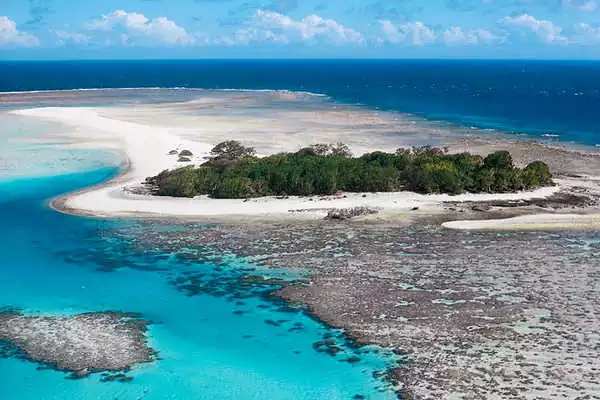The Great Barrier Reef is undoubtedly one of the most breathtaking natural wonders, attracting millions of visitors every year. However, it’s essential to know the worst time to visit this awe-inspiring site, ensuring that you make the most of your trip.
Weather Conditions
When planning a trip to the Great Barrier Reef, it is crucial to consider the challenging weather conditions that can impact your visit. The region experiences two primary seasons, which bring different weather patterns.
The wet season, also known as summer, takes place from November to March. During this time, the area is prone to heavy rains and tropical storms, making it difficult to fully enjoy snorkeling and diving activities. The strong currents and reduced visibility may put a damper on your underwater exploration.
On the other hand, the dry season, or winter, lasts from April to October. This season is generally more favorable for visitors, with calmer weather conditions, milder temperatures, and less rainfall. Snorkeling and diving enthusiasts can benefit from improved visibility, allowing them to witness the vibrant coral reefs and marine life in all their glory.
It is important to note that even during the dry season, weather patterns can vary, and occasional rainfall or strong winds can still occur. Therefore, it is always wise to check the weather forecast and plan your trip accordingly.
In conclusion, understanding the weather conditions is essential when deciding on the best time to visit the Great Barrier Reef. By avoiding the wet season and its challenging conditions, you can ensure a more enjoyable and memorable experience exploring the wonders of this iconic natural wonder.
Cyclone Season
Discover why the cyclone season, usually from November to April, is widely regarded as the worst time to visit the Great Barrier Reef. During this period, heavy rainfall and strong winds are prevalent, making it challenging for visitors to enjoy the beauty of the reef. The unpredictable weather can disrupt any plans that you might have for exploration or recreational activities on the reef, making it less than ideal for a trip.
Unfavorable Water Conditions
When cyclones occur and heavy rains ensue, the runoff from the land washes sediment into the ocean. This increased sediment runoff contributes to reduced water clarity, and as a result, the vibrant colors of the coral are compromised. The sediment particles in the water can block sunlight from reaching the coral, hindering their photosynthesis and overall health. These unfavorable water conditions not only impact the appearance of the reef but also affect the overall ecosystem and biodiversity of the marine life that calls it home.
Stinger Season
Experience the thrill and danger of stinger season, a period that falls during the warmer months when deadly jellyfish infest the waters of the Great Barrier Reef. To ensure your safety, it is essential to don stinger suits, providing sufficient protection against these formidable creatures. Transitioning from tranquil splendor to a realm of caution, stinger season can heighten the thrill and remind visitors of the fragile balance of this marine ecosystem.
Tourist Crowds
Escape the hustle and bustle of tourist-packed peak seasons when planning your trip to the Great Barrier Reef. As a popular destination, the reef experiences high visitor numbers, leading to overcrowding, long queues, and a compromised overall experience. By avoiding peak seasons, you can enjoy a more peaceful and intimate encounter with the breathtaking beauty of the underwater world. Embark on your adventure when the reef is quieter, allowing for closer connections with its vibrant marine life. Your journey to the Great Barrier Reef will truly be a memorable and unspoiled experience.
Climate Change Impact
Discover the undesirable effects of climate change and rising sea temperatures on the Great Barrier Reef. Over time, these factors are gradually deteriorating the health and vibrancy of the reef, resulting in a less pleasant experience for visitors.
Coral Bleaching
Delve into the alarming consequences of coral bleaching events triggered by warmer waters. Such events can cause coral death, leading to a less colorful and diverse underwater ecosystem to explore.
Conclusion
In conclusion, choosing the best time to visit the Great Barrier Reef is crucial for a fantastic experience. By considering factors such as weather, marine life, and tourism seasons, visitors can plan their trip accordingly. Whether you prefer to avoid jellyfish stings or witness the marvelous coral spawning, timing your visit right is essential. Remember to check for peak tourist seasons and book your tours in advance to ensure availability. Regardless of when you visit, the Great Barrier Reef promises breathtaking beauty and unforgettable memories.
In conclusion, while the Great Barrier Reef is undoubtedly a breathtaking destination to explore, it is essential to time your visit wisely to ensure a memorable and fulfilling experience. By avoiding the peak tourist season, which corresponds to the wet and cyclone-prone summer months, you can make the most of your trip and enjoy the reef’s incredible beauty without the crowds. Whether you choose to discover the underwater wonders during the cooler and drier months or take advantage of the lower prices and pleasant weather in the shoulder seasons, planning your visit strategically will undoubtedly enhance your overall enjoyment. So, set sail for the Great Barrier Reef at the right time, and get ready to embark on a journey that will leave you spellbound, with memories that will last a lifetime.
